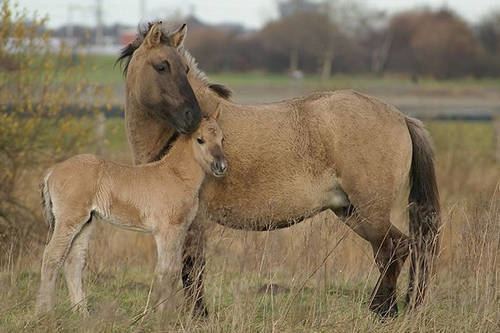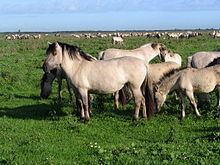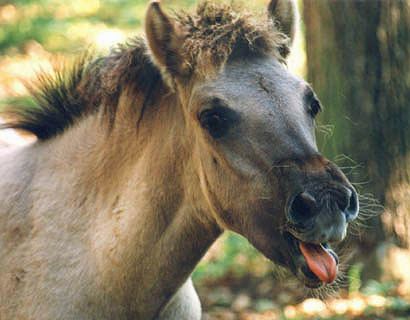Conservation status [not recognized Country of origin Poland | Scientific name Equus ferus caballus Rank Breed | |
 | ||
Similar Tarpan, Hucul pony, Czech Warmblood, Przewalski's horse, Heck cattle | ||
The Konik (Polish: konik polski or konik biłgorajski) or Polish primitive horse is a small, semi-feral horse, originating in Poland. The Polish word konik (plural koniki) is the diminutive of koń, the Polish word for "horse" (sometimes confused with kuc, kucyk meaning "pony"). However, the name "konik" or "Polish konik" is used to refer to certain specific breeds. Koniks show many primitive markings, including a dun coat and dorsal stripe.
Contents

Polish konik polish heritage
Characteristics

The breed has a strong and stocky build, small head with a straight profile, and a neck set low out of the chest. The Konik has a deep chest, a thick mane, and the hair coat is blue dun, often colloquially called "mouse-gray". The Konik is short in height, ranging from 130–140 cm (12.3–13.3 hands). Minimum heartgirth measurement is 165 cm (65 in), and minimum cannon bone measurement 16.5 cm (6.5 in) for mares, 17.5 cm (6.9 in) for stallions. Weight is 350–400 kg (770–880 lb).
History

The Konik is a Polish horse breed descending from very hardy horses from the Biłgoraj region. These horses had a predominantly dun colour, but also black and chestnut horses were present in the population. Some researchers claim these foundation animals were hybrids with wild horse breeding that had been sold to farmers by the zoo in Zamość in 1806, which were bred to local domesticated draft horses. However, genetic studies now contradict the view that the Konik is a surviving form of Eastern European wild horse, commonly called the tarpan, nor is it closely related to them. The Konik shares mitochondrial DNA with many other domesticated horse breeds and their Y-DNA is nearly identical.

During World War I, these horses were important transport animals for Russian and German troops and were called Panje horses. In 1923, Tadeusz Vetulani, an agriculturalist from Kraków, started to get interested in the Panje horses, a landrace of Biłgoraj and coined the name “Konik” (Polish for “small horse”), which is now established as the common name for the breed. During the 1920s, several public and private studs were created to conserve this animal. In 1936, Vetulani opened a Konik reserve in the Białowieża Forest. He was convinced that if horses were exposed to natural conditions, they would redevelop their original phenotype. While Vetulani's experiments are well-known and widely publicized, his stock actually had only a minor influence on the modern Konik population. However, World War II marked the end of Vetulani’s "breeding back" project. His stock was moved to Popielno, where they continued to live in semiferal conditions. Popielno became the breed’s main stud during the 1950s, but the herd was also preserved by buying animals from Germany.

Between the two world wars, the German brothers Heinz and Lutz Heck crossed stallions of Przewalski's horse with mares of the Konik horse, as well as mares of other breeds such as the Dülmen pony, Gotland pony, and the Icelandic horse, to create a breed resembling their understanding of the tarpan phenotype. The result is called the Heck Horse. Other breeders crossed Koniks with Anglo Arabians or the Thoroughbred to increase their quality as a riding horse.
Breeding centres and nature reserves
Koniks today are bred either in barns or open reserves and under human guidance. The Konik was bred for a larger shoulder height in past decades, to improve its value as a working horse. A more graceful appearance, especially of the head, was established, as well. Black and sorrel horses have been largely selected out, but still appear on occasion, as do white markings. The simultaneous management of Koniks in both barns and reserves made it possible to compare the health and behaviour of the horses under different circumstances. For example, hoof diseases and hay allergies are more common in Koniks raised in barns than in reserves.
In Poland, Koniks currently live on nature reserves at Popielno, Roztocze National Park, Stobnica Research Station of the University of Life Sciences in Poznań. They are bred in controlled conditions at a state stud at Popielno, Sieraków. Private breeders currently own 310 mares and 90 stallions; the state studs own 120 mares and 50 stallions.
As it phenotypically resembles the extinct tarpan, the Konik has also been introduced into nature reserves in other nations. One of the first was the Oostvaardersplassen in the Netherlands. In 1995, a herd was released in de Kleine Weerd, a 12-hectare strip of land (roughly 100 m by 1 km) along the river Meuse near Maastricht. The area is open to the public, but people are advised not to go near the horses because their reactions are unpredictable. Following the success of this program, Koniks were also brought to Latvia and to the United Kingdom, where they were placed in Wicken Fen near Cambridge by the National Trust. Due to the efforts of the Wildwood Trust, a charity which operates the Wildwood Discovery Park, and the Kent Wildlife Trust, Koniks also now live on several additional reserves, including the Stodmarsh National Nature Reserve, Ham Fen National Nature Reserve, Whitehall Meadow, Sandwich Bay, and Park Gate Down. In addition, the Suffolk Wildlife Trust introduced Polish Koniks for grazing as part of a broad restoration project of the Redgrave and Lopham Fen. Sussex Wildlife Trust have recently introduced a small herd in and around the Mount Caburn nature reserve.
The view that the Polish Konik is the most recent descendant of the European wild horse, and resembling it, as well, has been debunked. Mythologization and perceptions have made a mere Polish farm horse into an allegedly bred-back 'wild horse' and an icon of new grazing management in European nature reserves.
